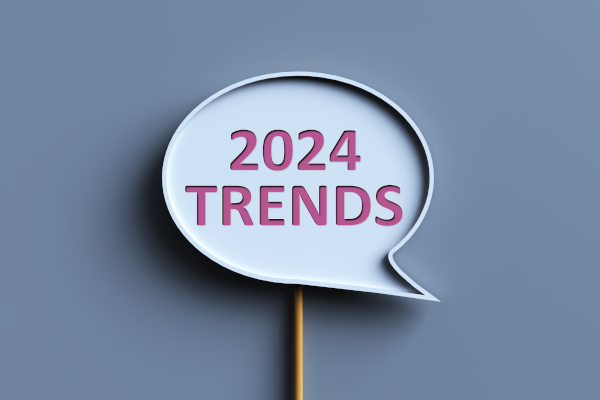Supply Chain’s Top Trends for 2024 Require Talent Investment for Success
Many companies invest in technology to solve problems, but people are still critical to finding ROI says ASCM CEO Abe Eshkenazi

The Association for Supply Chain Management’s (ASCM) annual supply chain trends list for 2024, which was released in September, featured many of the same trends seen in previous years: digitization, investments in technology, and disruption.
But a couple of themes that underpin most items on the list are resiliency and talent acquisition/retention concerns. Abe Eshkenazi, CEO of ASCM, spoke with Supply Chain Management Review to discuss some of the items on the list and the broader concerns facing the supply chain as we wait for the ball to drop on 2024.
“When we consider the environment we are in today … We are on the back side of the bullwhip effect trying to get supply and demand balanced,” Eshkenazi said. “Most of the focus now is on resiliency an agility. Very few companies are not focused on resiliency.”
Eshkenazi noted that companies are still trying to develop strategies to navigate around continued disruptions.
“Efficiency and effectiveness is still the hallmark of every supply chain,” he said. “The focus is on digital transformation, big data, and using technology to address the trends we saw.”
With investment continuing (it was number 4 on the ASCM list), the industry continues to gain more insight into operations and the broader supply base. That, Eshkenazi said, is a good-bad scenario for many businesses.
Visibility’s impact
“The good news/bad news is we spent a lot of time focused on visibility and transparency so we know everybody in our supply chain,” he noted, “but the bad news is we now know everybody in our supply chain. So we have awareness (to everything and the risks).”
Many of those investments have come in the form of new technologies and solutions, but Eshkenazi said it is important to remember that the best technology is not going to provide the expected outcome without an investment in the people.
“This is where we need to focus a little bit more, on the talent. That challenge has not gone away,” he said, noting that part of the issue is a “volume problem.”
“We don’t have enough supply chain individuals entering the workforce,” he said. “On the back side, historically, it was sufficient to be a supply chain subject matter expertise … today, that is the price of entry.”
To illustrate, Eshkenazi pointed to the sustainability and compliance initiatives many companies have undertaken. Increased visibility is key to meeting these new demands, but that is also increasing the need for compliance, which requires workers, he said.
Training talent
To inject more workers into the supply chain, and to upskill those already in the workforce, requires time and investment.
“Every organization is plowing significant resources into their technology side, into their resources, but one of the critical gaps we have is [less investment in the people training to do this],” Eshkenazi said. “People coming in have skills, but not the critical thinking required. People in industry have critical thinking but not the tech thinking. Unfortunately, we are not seeing this [being solved in schools].”
Cybersecurity concerns
Eshkenazi are also seeing more cybersecurity concerns, especially as more suppliers get connected via technology integrations.
“It should be a conversation every single day,” he said. “We have seen a continued increase in cybersecurity attacks. It’s more crucial as we invest more in AI … we are creating more potential for cybersecurity threats. The threats that are posed are coming through the backdoor. Your partners may not be as diligent as your organization.”
This also begs for a talent infusion to monitor threats, which are becoming more visible as transparency in the industry increases.
While technology, visibility, risk assessment and investment continue to dominate top trends heading into 2024, they all require an investment in the talent to make sure those investments prove valuable.
“You have to start with the talent side,” Eshkenazi said. “If you don’t have the right people with the right skills, there is no way to get the ROI on the technology side.”

Article Topics
ASCM News & Resources
The reBound Podcast: Innovation in the 3PL supply chain Learn about Digital SCOR on The Rebound Podcast Say so long to 2022 on The Rebound Take a deep dive into ASCM’s 2022 salary and career report on The Rebound Speaking up for diversity and inclusion in the supply chain on The Rebound The Rebound Podcast: Simplifying digital transformation Live From ASCM Connect - The Great Supply Chain Disruption More ASCMLatest in Materials Handling
RoboGeorgia launches to make Georgia a leading robotics and automation hub Vehicle-mounted computers: Beyond rugged New packaging idea for the cold chain Autonomous mobile robots (AMRs) offer modern solution to challenges of traditional farming Hyster-Yale Group provides students with real-world AI experience in 2024 Kellogg Design Challenge KION Group’s board extends CEO Rob Smith’s contract by five years UniCarriers Forklift joins Quality Equipment in opening celebration of new location More Materials HandlingAbout the Author
Subscribe to Materials Handling Magazine

Find out what the world's most innovative companies are doing to improve productivity in their plants and distribution centers.
Start your FREE subscription today.
April 2024 Modern Materials Handling

Latest Resources











